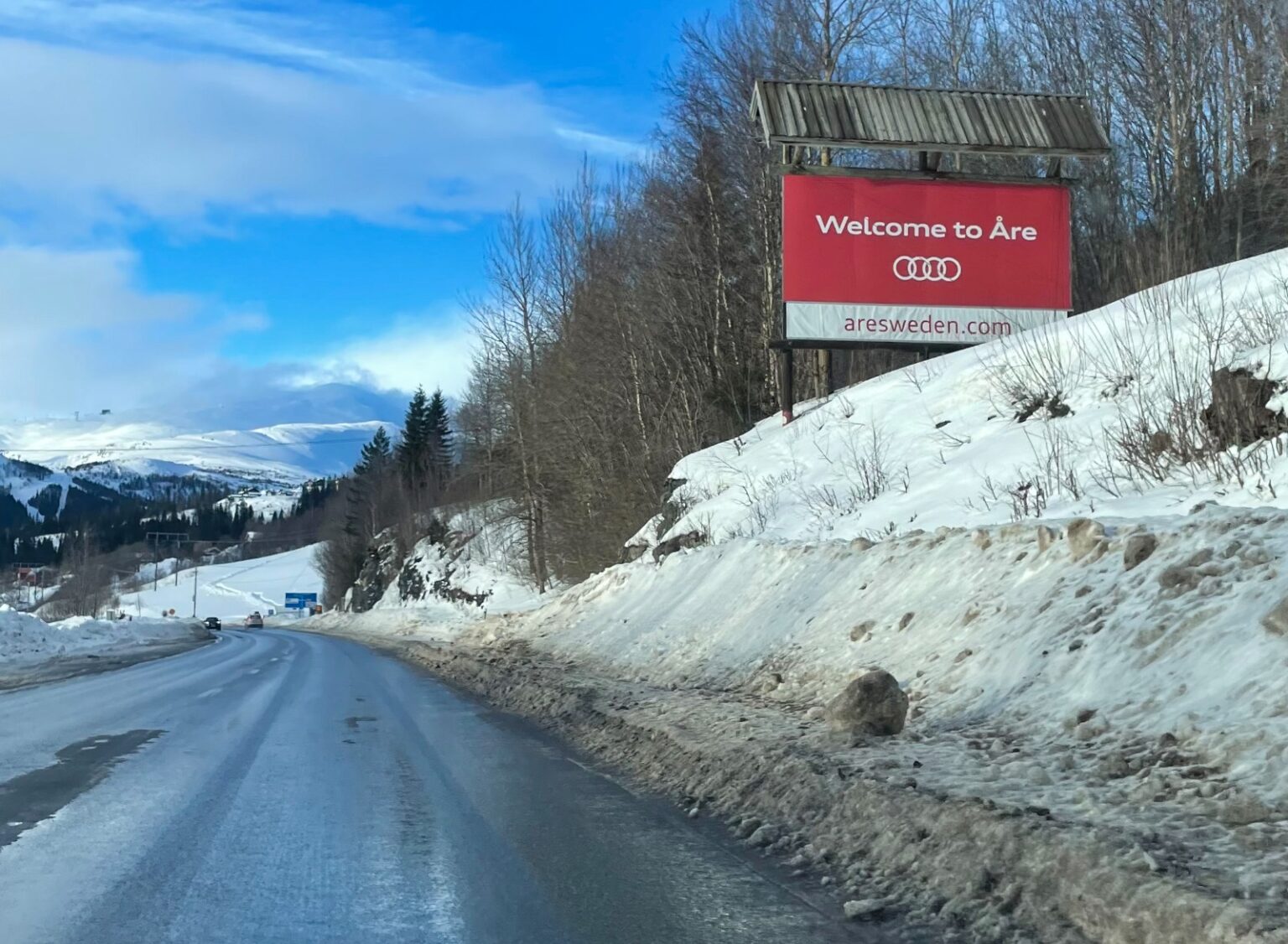Would a chicken run be sponsored by foxes, or a mouse party by cats? Not only would that be extremely provocative, it would join actors whose survival interests are in fundamental conflict. So, why is sponsorship from major climate polluters pouring into winter sports like an oil slick, just as snow sports’ very existence is threatened by global heating?
It’s not a small problem, like the odd stone hidden in a snowball. The carbon dioxide emissions (CO2) of just seven polluting winter sports sponsors — Audi, Ford, SAS, Equinor, Aker, Volvo, Preem — would melt an area of 1,968 square kilometres of spring snow each year.
To put that into perspective, it’s equal to a land surface area 437 times bigger than the skiing area of Åre; Sweden’s largest ski resort, and a potential bidder for the 2030 Winter Olympics.
These findings are in our new report ‘Dirty Snow’, published by the New Weather Institute and New Weather Sweden for the Badvertsing campaign, to coincide with the International Ski & Snowboard Federation (FIS) Alpine World Cup Finals 2024, and to launch the new Save Our Snow campaign. The area of spring snow that would be melted by the same combined emissions of the seven winter sports sponsors would be 195 times bigger than the skiing area of Skicircus Saalbach, host of this year’s Alpine World Cup Finals, and one of the world’s largest skiing venues.
Such an obvious conflict of interest, between high-carbon businesses fuelling a warming planet, and sports that need things to stay cool, is fairly easy to grasp. What has been less appreciated or quantified, is the degree to which these sponsorship deals with polluters — forms of advertising — might themselves be actually increasing emissions. The logic, once seen, is simple. Any commercial enterprise expects a return on investment, and advertising and sponsorships are there to support a company’s growth-oriented business model.
‘Sell More Cars’
As a marketing manager for car maker Volvo, sponsor of Vasaloppet, the world’s biggest cross country ski race, put it, sponsorships are ultimately about selling more product: “There are many good reasons for Volvo to be engaged actively in sports… We increase awareness of our trademark. And, naturally, we sell more cars.”
Knowing the carbon footprint of a company and the typical expectations for returns on spending makes it possible to estimate the additional emissions generated by promotional sponsorship deals. The figure will be different for each company, but we found that among the heavily polluting winter sports sponsors studied, a fossil fuel sponsorship deal can easily generate up to 100 kilogrammes of CO2e for every euro of sponsorship.
As a leading progressive economist, Professor Richard Murphy of Sheffield University Management School, said: “What this work shows is that… companies’ pollution can be reliably linked to the activities that they sponsor in a way that could be replicated by anyone thinking of accepting sponsorship from big carbon producers. Money from those companies comes laden with carbon emissions. This methodology shows how to estimate just how much on a reliable and comparable basis. Every sponsorship deal should be appraised in this way.”
For example, the car maker Audi is a main sponsor of the FIS World Cup Finals, and it’s estimated that its sponsorship deal will generate between 103,000–144,000 tonnes of CO2 — equivalent to burning between 238,000 and 333,000 barrels of oil.
Stolen Winters
Winter sports are already vulnerable to climate change and rising global temperatures. Several alpine and cross-country ski races have been cancelled halfway into the 2023-24 season: as of February 21, nine of the planned Alpine Ski World Cup races of the season have been cancelled. On current trends, in mid-latitudes in the Northern Hemisphere winters are expected to continue to shrink by 4.7 days per decade. In a high-emission scenario, by the end of the century, winter could shrink to a single month from mid-December to mid-January.
A growing majority of ski slopes in the European Alps are also reliant on artificial snow, an energy-intensive endeavour that can further increase emissions. Approximately one quarter of skiing areas in Germany, 39 percent in France; 54 percent in Switzerland; 70 percent in Austria; and a whopping 90 percent of ski areas in Italy are served by artificial snow. The situation will only worsen without deep and immediate emissions cuts.
With major polluters like fossil fuel companies, airlines and car makers increasingly exposed as having business models that conflict with climate and human health goals, their choice of using snow sports sponsorship as a billboard is a careful tactical manoeuvre. Research shows that winter sports fans are generally more actively engaged, and that there are fewer negative attitudes towards sponsors of winter sports than towards those sponsoring other sports. In fact, experts say that because of these reasons, winter sports are more attractive to sponsors than, for example, football.
Fans transfer some of the positive emotions that have towards the sports to the sponsor. That means companies with bigger reputational issues, perhaps because they are big polluters, might be disproportionately drawn to the clean, natural landscapes and healthy outdoor pursuit of winter sports. They get a bigger PR bang for their buck.
But it means that sponsors are compounding the existential threats already posed to winter sports due to rising global temperatures and shifting snowfall patterns, with Europe’s ski resorts suffering at the hands of record-breaking temperatures. Each euro from Equinor’s sponsorship of the Norwegian Ski Federation will generate increased emissions of 26.4 kg CO2e and the company’s total emissions is estimated to be responsible for the loss of 635 square kilometres (km2) of snow cover each year. Equinor is the subject of heated protests in both the UK and Norway over their attempts to open the Rosebank oilfield.
The problem of winter sports being publicly aligned with polluters who will ultimately be their nemesis goes deep, too. Björn Sandström is a Swedish elite cross country skier and environmental scientist. He makes the point that currently the sports whole ‘offer’ may be undermining its future: “Many sports federations and professional athletes are marketing an idealised, elite lifestyle with high consumption of products and travel. This sends a message to younger generations leading to more people striving towards this ‘glamorous life.'” These are behaviours, argues Sandström, that “are leading us deeper into the climate crisis” and that we have to leave behind.
Clean Sponsors
Emil Johansson Kringstad, a former Swedish elite cross country skier, agrees saying: “Sponsorship from high carbon footprint companies destroys winter-sports. As a former member of the Swedish national ski team, I wish that ski associations and races would stop promoting companies that melt our sport away.”
What exactly should be done to change the situation? The debate is now growing among winter sports athletes. Anna Turney, a former British alpine skier and Paralympian, says: “Snow sports have given me a huge amount of freedom — and now that freedom is under threat from climate change. Not as a distant risk, but as an immediate peril.” She thinks that now, “Snow sports organisations need to show courage and be brave if they are to secure a flourishing future for snow sport. They need to do things differently and that must start with which companies they promote and associate with.”
Former Dutch elite skater, Mark Ooijevaar, is even more specific, arguing that, “High-carbon sponsorship in sports needs to be replaced by sponsorship from companies that are building a fossil-free future.”
One thing is now very clear: Every dollar, pound or euro of sponsorship from major polluters is like a blowtorch turned on the future of winter sports. These sponsors are not charitable donors, but self-interested corporations whose polluting business models are in conflict with the climate that snow sports depend on. They’re using sport as a billboard to sell more high-carbon products that are killing our winters and now, for the first time, we can put a figure on the damage their money does. Organisations, events and teams need to drop sponsors who are leaving the slopes bare, because for snow sports self-immolation is not a viable strategy.
Andrew Simms is a director of the New Weather Institute, co-founder of the Badvertising campaign, assistant director of Scientists for Global Responsibility, and co-author of ‘Dirty Snow: how a ban on polluter sponsorships in winter sports can help save our snow’. Follow on X @AndrewSimms_uk or Mastodon. @[email protected].
Anna Jonsson is co-director of New Weather Sweden, a co-author of the report ‘Dirty Snow’ and a co-founder of the new campaign Save Our Snow.
Subscribe to our newsletter
Stay up to date with DeSmog news and alerts






